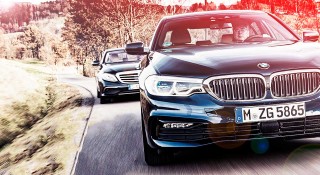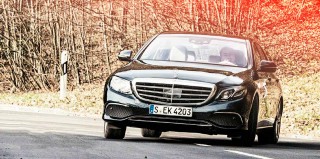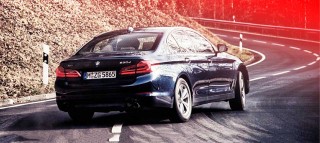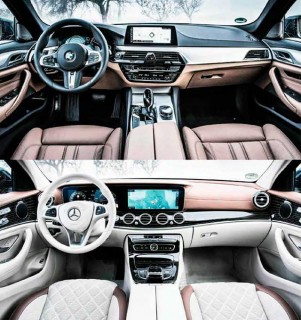BMW BUILDS THE BETTER BENZ
The Mercedes-Benz E-Class laid down quite the marker when it launched earlier this year. Buyers got more space thanks to a 43mm longer body with an extra 65mm between the wheels; more power and better economy; a similarly giant leap in interior quality that we witnessed with the C-class 205 Series; and there was tech galore, with a widescreen instrument display, autonomous lanechange capability, car-to-infrastructure communication and much more. Mercedes called it ‘the most intelligent business saloon’, and with some justification.

Along with the refreshed C- and S-class, the new E W213 has been a key weapon in Mercedes’ – likely successful – battle to overtake BMW for the global premium sales crown by the year’s end. Munich, clearly, has not taken this lightly. It’s been busily re-loading the arsenal in a product counter-attack: first the 7-series, now this, the new 5-series G30/G31.
The 5-series might not have the exotic carbonfibre core of the latest 7-series G11/G12, but the seventh-generation model is up to 100kg lighter than its predecessor thanks to a multi-material mix of aluminium, high-strength steel and even magnesium. That’s despite it being some 36mm longer, 6mm wider and 2mm taller, with a 7mm stretch to the wheelbase to unlock interior space. It’s roomier, faster, more frugal, and, says BMW, more refined and quieter too. It’s also loaded with tech, including a 10.25-inch touchscreen that you can interact with via the iDrive rotary control, Gesture Control or by talking at it. There are endless driver-assistance systems too, including stuff to keep you in – and autonomously steer you from – your lane.
At launch, a 530i, 540i xDrive or 520d or 530d (the diesels both offered optionally with xDrive) are available. For this showdown, we’re pitching 530d xDrive against Mercedes’ E350d. The BMW’s 261bhp/457lb ft straight six plays the Mercedes’ 254bhp/457lb ft. But, more importantly in this battle for your company-car cash, 60.1mpg and 124g/km CO2 (or 53.2mpg and 138g/km CO2 in xDrive trim) plays the Merc’s 55.4mpg/133g/ km. Prices start from £43,835 for a non-xDrive BMW, £44,130 for the Mercedes.
The top three brand values typically associated with the three-pointed star are quality, safety and comfort. In contrast, the BMW roundel stands for performance, driving pleasure and design. But if this match is anything to go by, these parameters require revision. Design? Like the 7-series G11/G12, the new 5-series G30 is a textbook example of nicely put together blandness. Timeless styling may be a good thing, but not when a brand-new product looks three years old. The E-class is a bigger C-class or a smaller S-class, depending on the eye of the beholder. While it may be pretty, functional and well proportioned, distinctive it is not.

Inside, BMW has finally caught up with the level of material quality and craftsmanship Audi and Mercedes have been cultivating for decades. While the cockpit of the 530d tends to prioritise driver-focused essentials, the cabin of its opponent is a beautifully executed exercise in flamboyant traditional luxury. What about the driving dynamics? We’re about to find out.
The first leg of our journey takes us to the autobahn, where it’s a dead-heat between Munich and Stuttgart. Top speed is electronically capped, directional stability gives no reason for concern and in-gear acceleration kicks butt relentlessly. This is also a chance to put both cars’ infotainment systems and myriad semi-autonomous driver aids to the test.
Ergonomically, both leave much to be desired. Although BMW in particular has pushed voice control to a new level, complexity remains the name of the game, distraction is a bigger-than-ever issue, and safety is suffering in an age that should be more safety-conscious than ever. The BMW’s electronic epicentre, for instance, can be accessed via touchscreen, iDrive and steering wheel, but the process is a real challenge for uneducated fingers and a confused brain.
Both cars are crammed with super-intelligent assistance systems capable of mapping the route to fully autonomous driving, introducing new automatisms to change lanes or stay in lane, accelerate and brake while respecting distances and speed limits, parking the car and later helping you find it.
Temporary eyes- and hands-off the wheel is an integral part of the so-called Driving Assistant Plus BMW is introducing with the new 5-series. Although it covers speeds up to 130mph, I find myself sweating at 50-70mph in self-driving mode, eyes alternatingly roaming the small steering-wheel symbol in the instrument panel, the green-lane demarcations next to it, and the real road ahead for reassurance. Brave new world, indeed.

Swapping cars means briefly adjusting the approach, but the underlying technology is similar. Like the 5-series, the E-class can be equipped with numerous driver aids designed to make life easier and safer in heavy traffic. Active cruise control accomplishes both missions, except the system tends to mistake slip roads for a clear piece of motorway, which forces you to brake twice as hard to slow the self-accelerating vehicle. Computer-controlled lane discipline works well until the lane starts to bend and tighten, at which point Scotty must swiftly re-take control. Closing gaps automatically is another well-intentioned feature, which tends to be thwarted in real life by queue jumpers and late brakers.
Not surprisingly, confidence dips as car and driver disagree on whether, when and how to react. Since software and sensors are of the essence here, 530d edges slightly older E350d in terms of smooth, progressive action. But after several hours of semi-autonomous trial and error, frustration sets in, off buttons are pressed, and we seek out roads to reveal how these cars actually drive.
While the BMW has conventional springs and dampers, the E-class is, like C- and S-class, available with air suspension. It’s only on second-rate Band C-roads dotted with corners, dips and crests that the 530d starts pulling away. Grip is not the decider here, but the BMW’s more switched-on handling does make a difference. More surprisingly, the new 5-series is also quieter and smoother riding. While the E350d copes very well with long undulations and longitudinal grooves, it feels less comfortable over ripples, edges and cracks.

Although the absorption talents of the E-class are devoid of uncouthness, the Mercedes feels a little more wooden, a trifle less composed, plop-plopping more audibly through potholes. Switching the set-up from Sport to Comfort increases wheel travel and overall suppleness, but fails to pad the air suspension with extra pillows. Stepping back into the BMW means shaking your head in disbelief. The 5-series feels tauter and better connected, and it filters irritations and impulses more efficiently, not by means of eiderdowns but through enhanced physical compliance. The above-par ride quality degrades only from excellent to good as you flick the drive controller from Comfort to Sport.

The 530d collects extra Brownie points for its comprehensively soundproofed running gear, the well suppressed wind- and tyre noise, and the trademark straight six, which drinks diesel but talks with almost the same velvety voice as its petrol sibling. Although Mercedes has over many years done a fine job evolving the legacy of Rudolf Diesel, the V6 tested here is still a relatively old-school powerplant, frugal but not exactly smooth. Idle speed is vaguely reminiscent of a distant truck at tickover; noise, vibration and harshness are undercover brothers-in-arms; plentiful low-end torque (457lb ft from 1600-2400rpm) has priority over high revs (254bhp at 3400rpm) and brisk throttle response. Of course, that’s all fine and dandy for coasting at leisure, watching cobwebs grow around the shift paddles. But in terms of finesse, quietness and seamless performance, the BMW engine has the edge. Note that Mercedes will switch from V6 to straight six later in 2017.
Few will demand more from their mid-sized execs than a high-speed autobahn schlep and a quick-ish cross-country run, but in the name of research we headed to a secluded six-mile climb from the river Danube to the lower edge of the picturesque Mühlviertel, a perfect staging ground for ‘The great German torque versus French tyres shootout’. The topographic menu includes fresh blacktop, zero traffic and long straights followed by fast sweepers which invariably climax in second-gear hairpins. If you wanted to put a number on paradise, it would be the B2367 from Jochenstein to Gottsdorf.
In the BMW, the stability-control off button and the drive mode selector required to dial in Sport or Sport Plus are positioned next to the gear lever. In the Benz, the stability-control function can be found on the first level of the menu labelled ‘car’. On the transmission tunnel, there is a direct-access toggle switch to tweak the dynamic DNA. Piece of cake.

The V6-engined Mercedes is an entertaining bit of kit. It approaches the first right-hander with stoic steadfastedness, puts the nose down under hard braking and turns-in with obedience, the front-wheels eyeing the apex, the rear wheels screaming for entertainment. It definitely stimulates one’s hooligan vibes. Taking off a bit of lock whilst adding a little more torque is all it takes to stage a gracious four-wheel slide undisturbed by an electronic watchdog that cannot be entirely disengaged.
In spite of the optional air suspension labelled Air Body Control, lean and roll are quite emphatic, and so is the brief wriggle that terminates the cornering performance.
Our 530d is fitted with xDrive, which duly steps back a couple of paces the instant stability control exits the stage. Reeling in the road between bends, the BMW feels flatter and better tied down than the E-class as well as more focused and less like a four-door notchback. Its steering is quicker, lighter and more switched on, even if the fat rim could do with less padding.
The key difference is that this particular 5-series steers as well as drives with all four wheels thanks to Integral Active Steering. A feature worth having? Yes, not necessarily for the quicker turnin but for the more inspiring interaction between axles. Instead of following a set radius, the rear wheels live, within limits, a life of their own. The bottom-line benefit is a mix of higher cornering speed, better agility, quicker feedback and enhanced grip.

While ticking boxes, one should also specify Dynamic Damper Control, which comes with the adaptive drive-mode selector. The benefit of Dynamic Drive, BMW-speak for adjustable anti- roll bars, is on the other hand less obvious. It adds weight and won’t work in combination with Integral Active Steering.
Stability still deactivated, the new four-wheel-steer 5-series requires smaller steering inputs to change direction, and there is no pronounced weight transfer needed to kickstart the skating action. Creaminess is the first word that comes to mind when the 530d morphs from carving to drifting, describing one clean arc after the other as if guided by a pair of curve templates, signing the road here and there with fine black rubber crescents. While the E-class requires a heavy right foot and two quick arms to shed its in-built stateliness and composure, playfulness is second nature to the BMW.
The damage? During our two-day journey through Lower Bavaria, Upper Austria and the Czech Republic, our tyres were a little more worn than 600 miles would suggest, and BMW edged Mercedes at the pumps 29.0 to 27.4mpg. Not bad for a pair of hard-charging upmarket repmobiles, but the fact that our own numbers virtually half the makers’ claims is cause for concern.
So, time to choose our winner. Splendid isolation used to be a cornerstone of every product signed off in Untertürkheim and Sindelfingen, but that was at a time when many Mercedes owners wore coat and tie, a hat and, more often than not, a full face nourished by the Wirtschaftswunder. In 2016, the marque wants to be young and trendy, cool and digital, progressive and future-oriented. No wonder that current Mercedes are emphatically extrovert, aggressively techy and, on demand, expressively sporty. Matching this brief to perfection, the new E-class has become more driver-oriented, efficient, sustainable and chic. Compared with Audi A6 C7 and Jaguar XF, the Mercedes-Benz remains comfort king, but the new 5-series has got what it takes to upset this ranking. Not only does it offer a more convincing ride-and-handling balance, it is also quieter and more refined.
So after two days and 600 miles through three countries, the 5-series gets our vote, and this endorsement extends beyond the xDrive variant. The new BMW deserves a bottle of bubbly even in four-pot 530i guise, without extras like fancy steering, trick suspension or autonomous driving ballyhoo. True, it could be sharper, tail-happier, louder and stripped of some supplier- or marketing-induced filters and irritations. But as time moves on, connectivity and digitalisation are catching up fast with power and g-force. This paradigm shift, still a work in progress, could have been an opportunity for the E-class to seize the lead and defend it all the way to the chequered flag. Instead, the Mercedes comes second in vehicle dynamics and high-technology. It was a close race, but not a photo finish. The BMW wins on merit, and because it has learned to beat its arch-rival at its own game.
If our boat came in, we’d splash out on the BMW. Enough! BMW drives and cossets better. And the Mercedes-Benz is still excellent.
Twin test BMW 530d G30 vs. Mercedes-Benz E350d W213
SPECIFICATION BMW 530d xDrive SE G30
Price UK £45,965
Engine 2993cc 24v turbodiesel straight-six,261bhp @ 4000rpm, 457lb ft @ 2000rpm
Transmission Eight-speed auto ZF 8HP, all-wheel drive
Performance 5.4sec 0-62mph, 155mph, 53.2mpg, 138g/km CO2
Suspension Double-wishbone front, multi-link rear
Weight/made from 1770kg/aluminium, steel, magnesium
Length/width/height 4936/1868/1479mm
Rating 5
SPECIFICATION UK Mercedes-Benz E350d SE W213
Price £44,130
Engine 2987cc 24v turbodiesel V6, 254bhp @ 3400rpm, 457lb ft @ 1600rpm
Transmission Nine-speed auto MB, rear-wheel drive
Performance 5.9sec 0-62mph, 155mph, 55.4mpg, 133g/km CO2
Suspension Four-link front, multi-link rear, air suspension
Weight/made from 1890kg/aluminium, steel
Length/width/height 4923/1852/1475mm
Rating 4

Twin 12.3-inch widescreens are optional in E350d. Both superb quality, both laden with tech you‘ll still be fathoming come facelift time. Design even safer than driver aids. Could be last-gen 5-series vs S-class. 5-series might have all-wheel drive, but it still throws shapes. Optional Display Key allows remote operation of climate control, and to check if windows or doors are open, fuel level and more. Remember, semi-autonomous Driving Assistant Plus is optional. You can’t switch the ESP entirely off, but there’s still fun to be had in the Mercedes.
TECH VOODOO DEMYSTIFIED
BMW’s Integral Active Steering
Four-wheel steering isn’t new – Skylines and Preludes were fitted with it over two decades – but Integral Active Steering is relatively fresh to BMW. Instead of being fixed, the rear wheels move by up to three degrees. Below 36mph, the front and rear wheels turn in opposite directions for extra manoeuvrability. Above 36mph, they turn in the same direction, enhancing stability.
Merc’s widescreen infotainment
Available optionally, Mercedes-Benz offers twin 12.3-inch screens under a shared glass cover. One is the instrument binnacle with digital dials, the other the infotainment display. You can tailor the layouts to your liking. These aren’t touchscreens. Instead they’re controlled by the rotary Comand dial or you can scrawl characters – a postcode, say – on the touchpad hovering over it. Or use the touch-sensitive buttons on the steering wheel.
The battle of the straight-sixes
The Mercedes loses the engine war this time, its V6 inherently less smooth than BMW’s creamy straight six. But Mercedes were once fitted with straight and will be again soon. The new straight-six diesel will use a 48-volt electrical system and, in its second iteration, may switch to an e-compressor (right) Working in tandem with the regular turbo, it would deliver extra boost from 1000-3000rpm, eliminating lag, and any need for a sequential turbocharger.
{CONTENTPOLL [“id”: 91]}





